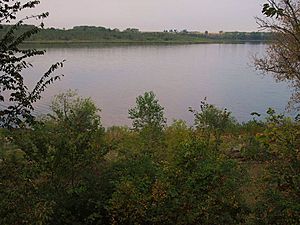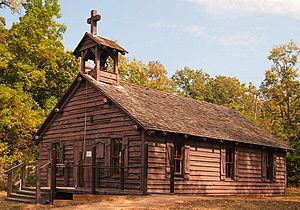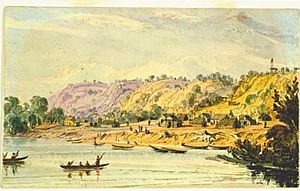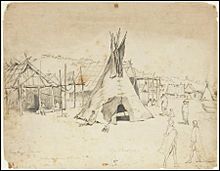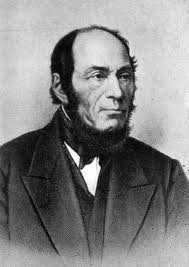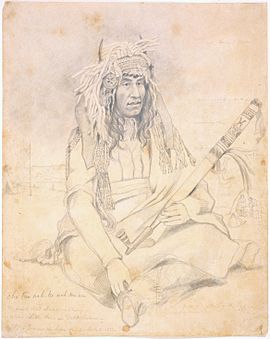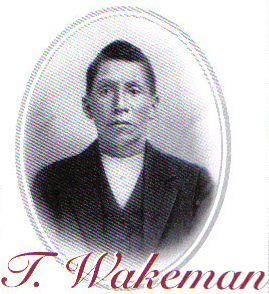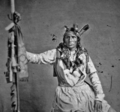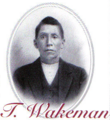Little Crow facts for kids
Quick facts for kids
Little Crow
|
|
|---|---|
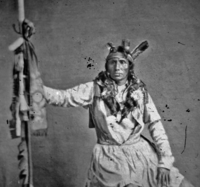
Taoyateduta, known as Little Crow
|
|
| Born | c. 1810 Kaposia (now in South St. Paul, Minnesota)
|
| Died | July 3, 1863 Minnesota
|
| Known for | Mdewakanton Dakota chief Leader in Dakota War of 1862 |
| Spouse(s) | Mazaiyagewin (Iron Cluster Woman) Saiceyewin (Isabelle Wakeman) Makatowin (Blue Earth, Eva Rice) Manikiyahewin |
| Children | Thomas Wakeman (Wowinape) Emma Jane Williams Hannah Redearth William Cleveland |
Little Crow III (in Dakota: Thaóyate Dúta; around 1810 – July 3, 1863) was a Mdewakanton Dakota chief. He led a group of the Dakota in a five-week war against the United States in 1862. This event is known as the Dakota War of 1862.
In 1846, after a difficult challenge to become chief, Taoyateduta took the name Little Crow. He played a key part in signing the 1851 Treaty of Mendota. This treaty gave most of the Dakota lands in what is now Minnesota and Iowa to the United States. In 1858, Little Crow went to Washington, D.C., with other Dakota leaders. There, the U.S. government pressured them to give up more of their land.
Back home, people were angry and didn't trust him. Little Crow lost an election for tribal spokesman in 1862. He then tried to change his traditional ways of life. That summer, the Dakota faced great hardship and hunger. Tensions grew with government agents, traders, and new settlers. On August 17, 1862, four Dakota hunters killed five settlers. Fearing punishment, they asked for help from Dakota chiefs who wanted war. They chose Little Crow to lead them. He first tried to stop them, saying fighting the "white men" was hopeless. But he finally agreed to lead them, promising to die with them. This led to a war that killed many settlers and took nearly 300 hostages.
Many Dakota, especially farmers, did not agree with Little Crow. They wanted peace and did not want to harm civilians or the captives. In September, Little Crow tried to talk with Colonel Henry Hastings Sibley. But Sibley refused to talk until the hostages were released. The American Civil War slowed the U.S. military response. However, Sibley's army defeated Little Crow's forces at the Battle of Wood Lake on September 23, 1862.
After this defeat, Little Crow stopped his followers from attacking other Dakota or killing the hostages. He then fled with some of his group to the northern plains. He hoped to get help from other Native American tribes and the British in Canada. Other tribes did not help him, and he had fewer and fewer supporters. Little Crow returned to Yellow Medicine with his son Wowinape in late June 1863. On July 3, 1863, two settlers, a father and son, shot and killed Little Crow. The state paid the father $500 for killing Little Crow. His son received $75 for Little Crow's scalp.
Little Crow's remains were later dug up by Army troops. In 1879, the Minnesota Historical Society put his remains on display. They were at the Minnesota State Capitol until 1915. Little Crow's grandson, Jesse Wakeman, asked for them to be removed. In 1971, the society finally returned Little Crow's remains to the Wakeman family. He was properly buried at the First Presbyterian Church and Cemetery (Flandreau, South Dakota). His burial site was added to the National Register of Historic Places in 2017.
Contents
Early Life and Family
There were at least three chiefs named Little Crow. This included Taoyateduta's grandfather, Cetanwakanmani, and his father, Wakinyantanka (Big Thunder). Taoyateduta himself became the most famous. The exact meaning of the name "Little Crow" is not fully clear. Some think it was a mistake for "Sparrowhawk." Others say the chiefs carried crow skins as a special symbol.
His Dakota name, Thaóyate Dúta, means "His Red Nation." Historians believe he was born in 1810. This is based on school records and his service in the Black Hawk War of 1832. He was one of at least ten boys born to Big Thunder and his three wives. Taoyateduta was likely the son of Big Thunder's first wife, Miniokadawin.
Growing Up in Kaposia Village
Taoyateduta was born in the Mdewakanton Dakota village of Kaposia. This village was also known as Little Crow's village. Kaposia was likely located on the east side of the Mississippi River. Around the time of Taoyateduta's birth, it was near what is now Indian Mounds Park.
After a land treaty in 1837, the Kaposia band moved across the river. They settled in what is now South St. Paul. As a young man, Taoyateduta left Kaposia. He faced disagreements with his half-brothers and others in the band. He rarely visited Kaposia for over ten years.
Years in Lac qui Parle
Taoyateduta later married and settled in Lac qui Parle. He married four daughters of a Wahpeton chief. He had at least twenty children with them. Physician Dr. Asa W. Daniels remembered Taoyateduta as a loving father. He was especially proud of his oldest son.
Lac qui Parle was also home to many of Taoyateduta's relatives. There, he learned to read and write in the Dakota language. He also learned some English and math. He studied at the Presbyterian mission school. He showed interest in Christianity but kept his native religion.
During this time, Taoyateduta was involved in trading. He was good with numbers and enjoyed gambling. Dr. Daniels said Taoyateduta had an amazing memory. He could remember promises made by government officials years before. He also knew the exact amount of money owed to his people.
In 1841, Taoyateduta went on a hunting trip with Henry Hastings Sibley. Sibley was a regional manager for the American Fur Company. Taoyateduta impressed everyone with his strength. He kept up on foot for five days while others rode horses. This showed he was willing to work hard to impress others.
Becoming a Chief
Big Thunder's Death
In October 1845, Taoyateduta's father, Big Thunder, was badly hurt. His gun went off by accident. Big Thunder died three days later. Before he died, Big Thunder named one of Taoyateduta's younger half-brothers as his successor. He was not happy with Taoyateduta. He gave his medals to the younger brother. This showed he was the chosen leader.
Historian Gary Clayton Anderson suggests that Henry Hastings Sibley might have confused Taoyateduta with his brother. Other accounts say Taoyateduta was far away when his father died. He did not learn of it until weeks later.
Return to Kaposia
After hearing of his father's death, Taoyateduta planned his return to Kaposia. He believed he should be chief. His two half-brothers were ready to fight him. They said his long absence meant he couldn't be chief. But Taoyateduta knew others in Kaposia would support him. They believed he had changed his ways.
In the spring of 1846, Taoyateduta returned. He came with a large group of friends and relatives. As they neared Kaposia, more supporters joined them. A big crowd met them at the river. Taoyateduta's half-brothers warned him not to land. They threatened to kill him. Taoyateduta stepped out of his canoe. He folded his arms and said, "Shoot then where all can see. I am not afraid." His brother shot him, hitting his forearms. Taoyateduta fell but was still alive.
He was taken to a surgeon, who wanted to cut off his arm. Taoyateduta refused. His wounds healed slowly, leaving scars and deformed wrists. He could not fully use his fingers again. Soon after, the village elders decided Taoyateduta had been brave. They saw his survival as a sign he was meant to be chief. His supporters then removed his two half-brothers. Taoyateduta became the chief of the Kaposia band. He then took the name "Little Crow."
Early Years as Chief
As a new chief, Little Crow took his duties seriously. He worked to reduce alcohol use in Kaposia. He himself stopped drinking for seven months. He became a strong supporter of sobriety. This program helped reduce drinking. Government officials noticed Little Crow's growing influence. In 1846, he said, "I was only a brave, then; I am a chief now."
Little Crow also invited Reverend Thomas Smith Williamson to Kaposia. Williamson opened a church and a school. Little Crow wanted his children to get an education. He also hoped for medical benefits, like smallpox vaccinations. Little Crow himself did not attend church often.
Education in Kaposia
Little Crow's main reason for inviting Williamson was education. He valued his own schooling and wanted the same for his children. His relatives also wanted schools. Little Crow and two of his half-brothers regularly attended Williamson's school. Many students enrolled, and attendance grew.
However, problems started when the government offered its own school programs. There were disputes over how to use money set aside for education. Traders encouraged the Dakota to oppose schools. They hoped the money would be given directly to people instead. Little Crow supported the mission school at first. But by 1849, he and his supporters stopped attending classes.
Williamson tried boarding schools to keep children in school. Little Crow supported this and sent two of his children, including his eldest son, Wowinape, and his daughter Emma. However, Little Crow later took them out of school. He could not convince everyone in his village to support education.
Trading and Hunting Activities
With less support for schools, Little Crow focused on trading and gambling for furs. He and others in Kaposia were involved in trading. This put them in competition with other traders. Little Crow was also successful in gambling for furs. He was also believed to have taken furs from Ojibwe hunters on Dakota lands. By trading, gambling, and hunting, Little Crow and the men of Kaposia added to their village's economy. They did not rely only on farming programs or government payments.
Treaty Negotiations and Challenges
In 1851, Little Crow was important in negotiating the Treaty of Mendota. This treaty gave the Mdewakanton and Wahpekute bands money for their lands. They agreed to move to a reservation along the Minnesota River. However, the U.S. Senate changed the treaty. The Dakota were forced to sign a new treaty. They were only given land on one side of the river.
In 1858, Little Crow led a group to Washington, D.C. There, he and other leaders were pressured to give up the northern half of their remaining lands. In the spring of 1862, Little Crow lost the election for tribal speaker. People mistrusted his role in the 1858 treaty. He also refused to support the farming program. After this political defeat, Little Crow became more open to changing his way of life.
However, things changed in the summer of 1862. The Dakota faced starvation due to poor harvests and limited hunting. Traders and agents refused to give food on credit. The government also failed to deliver yearly payments on time. This caused widespread anger, especially among those who did not farm.
Little Crow had tried to adapt to U.S. customs. He visited President James Buchanan. He wore American clothes and joined the Episcopal Church. He also tried farming. But by 1862, his people were starving. Crops had failed, and hunting was poor. Payments were delayed because of the American Civil War. There were rumors that the government had spent all its money on the war. As his people grew hungry, Little Crow found it harder to control them.
Dakota War of 1862
On August 4, 1862, a group of Dakota broke into a food warehouse. This happened at the Upper Sioux Agency. Lieutenant Timothy J. Sheehan realized peace needed food distribution. He called for help from Captain John S. Marsh. Little Crow rode to Yellow Medicine to discuss the issue. He met with agent Thomas J. Galbraith and others. Little Crow said the Dakota were owed money for food. He warned that "When men are hungry, they help themselves." A trader, Andrew Myrick, famously replied, "So far as I am concerned, if they are hungry let them eat grass." This angered the Dakota. Captain John S. Marsh arrived and ordered the warehouse opened.
On August 17, 1862, four young Dakota hunters killed five settlers. This happened near Acton. Fearing punishment, they went to other Dakota leaders. These leaders wanted war to drive settlers away. They asked Little Crow to lead them. Little Crow first tried to stop them. He said fighting the "white men" was useless. But he finally agreed, saying, "Taoyateduta is not a coward: I will die with you." A council declared war. Little Crow ordered an attack on the Lower Sioux Agency. This started the Dakota War of 1862.
Under Little Crow's leadership, the Dakota had some early successes. They ambushed U.S. troops at Redwood ferry. They also attacked a burial party in the Battle of Birch Coulee. Many unprepared settlers were killed. However, two Dakota attacks on Fort Ridgely failed. Soldiers and civilians used cannons to drive off the attackers. Little Crow was wounded in the second attack on Fort Ridgely. He did not join the attack on New Ulm. The Dakota attacked New Ulm twice, but settlers defended the town. Attacks on other towns and Fort Abercrombie were also stopped.
Little Crow's forces were defeated at the Battle of Wood Lake on September 23, 1862. After this, Little Crow and many warriors fled west. They took three white boys as captives. One boy, George Washington Ingalls, had seen his father killed. By late spring 1863, Little Crow and his followers were near the Canada–US border. They released the boys in early June 1863, in exchange for blankets and horses.
Death of Little Crow
Little Crow decided his people needed to live a mobile life. He led a group to steal horses from his old land in Minnesota. On July 3, 1863, he and his son Wowinape were picking raspberries. They were seen by Nathan Lamson and his son Chauncey. A short fight happened. Little Crow wounded the elder Lamson. But both Lamson and his son shot Little Crow, killing him. The chief told his own son to escape.
The Lamsons went to Hutchinson, Minnesota to report what happened. The next day, a search party found an unidentified Dakota man's body. The body wore a coat that belonged to a white settler killed two days before.
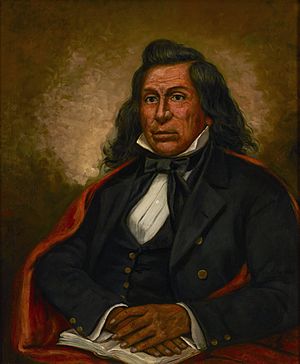
On July 28, 1863, Wowinape was captured by U.S. Army troops. He told them about Little Crow's death. Officials found and dug up the chief's body on August 16. Little Crow was identified by his scarred wrists. The next year, the state paid Nathan Lamson $500 for his service. His son Chauncey Lamson received $75 for the scalp.
The Minnesota Historical Society later got Little Crow's scalp and skull. These were displayed publicly for many years. In 1971, the Society returned Little Crow's remains to his grandson, Jesse Wakeman. He was buried properly. A small stone memorial was placed where Little Crow was killed.
Legacy
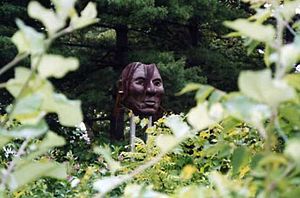
- In 1937, the city of Hutchinson put up a bronze statue of Little Crow. It was near the Crow River. The artist was Les Kouba.
- In 1971, Jesse Wakeman arranged for his grandfather's remains to be reburied. This was at the First Presbyterian Church and Cemetery (Flandreau, South Dakota). The church and cemetery were added to the U.S. National Register of Historic Places in 2017.
- In 1982, a new statue of Little Crow was made for Hutchinson. It was later moved for bridge construction. It was planned to be reinstalled in 2009.
- A mask honoring Little Crow was placed near a waterfall in Minnehaha Park in Minneapolis.
In Popular Culture
Chief Little Crow appears in Złoto Gór Czarnych (Gold of the Black Hills). This is a series of novels by Polish authors Alfred and Krystyna Szklarska. The story is told from the perspective of the Santee Dakota tribe.
See also
 In Spanish: Pequeño Cuervo para niños
In Spanish: Pequeño Cuervo para niños
Images for kids
-
Henry H. Cross, Little Crow. 1863. Minneapolis Institute of Art
-
Sculpture mask of Little Crow at Minneapolis


